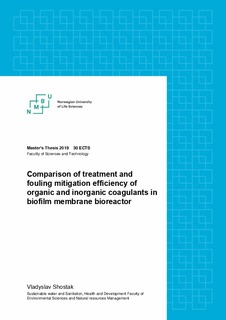| dc.description.abstract | Membrane bioreactors is an exemplary practice of sustainable wastewater treatment. Novel methods and approaches incorporating MBR allow not only treat wastewater with excellent efficiency, but also recover nutrients, recycle water, produce water with drinking water quality, produce and recover energy and carbon. These benefits provide limitless opportunities for MBR integration in almost any kind of field of wastewater treatment.
Still, the MBR technologies promise a lot of gains, there is a long way ahead before the MBR will overrun the world wastewater market. The most deterrent factor for MBR technology is a membrane fouling – it is evident from modern publications regarding MBR biggest fraction of which relates to the issue of membrane fouling. Numerous strategies for membrane fouling mitigation have been developed recently, starting from the upgrade of traditional mechanical cleaning, introducing adjustments in chemical cleaning and ending up in advanced biological methods for fouling control. Commonly applied chemical pre-treatment of water entering MBR has proved its reliability, enhanced treatment efficiency and ability to greatly prolong filtration time. However, it lacks sustainability, since chemical precipitation with conventional coagulants produces a large load of sludge, which is difficult for further handling due to low dewaterability and poor biodegradability. Also, residual aluminium in treated wastewater rises the risk of exposure to aluminium in food and drinking water, when recent findings assert that constant exposure to aluminium provokes Alzheimer disease and dementia. Thus, finding alternative chemical to precipitate and neutralize organic foulants (EPS and SMP) is an important task.
Chitosan is a natural polyelectrolyte produced from shells of crustaceans and is an excellent example of how wastes from food production can be converted to multi-purpose product. Ability to bind a wide range of substances makes chitosan outstanding flocculant. Chitosan proved to have the high binding ability of fats, fatty acids, polysaccharides, dyes and other organics which can contribute to biofilm growth and cause severe fouling of the membrane. Thus, it was interesting to try and investigate the anti-fouling abilities of chitosan and compare it with conventional coagulants.
Despite outstanding aggregating abilities, the results of the study show that chitosan is not so efficient in terms of fouling mitigation comparable to conventional aluminium sulfate. Moreover, low concentration of chitosan can accelerate fouling in MBR and high doses need to be applied to overcome dose range when chitosan acts as fouling enhancer. Reason for this is unclear and further study is needed, however findings from different research state the possibility of more intensive fouling due to low SMP removal by chitosan. The result of the study asserts that at optimal dosing chitosan is about 2.5 less effective than aluminium sulfate in terms of fouling mitigation. | nb_NO |

